Pennsylvania Amish
Over four dozen Amish communities can be found across Pennsylvania
 When most people think ‘Amish’, the first place that comes to mind is Lancaster County, Pennsylvania. The Keystone State is home to many more Amish besides those in Lancaster, however.
When most people think ‘Amish’, the first place that comes to mind is Lancaster County, Pennsylvania. The Keystone State is home to many more Amish besides those in Lancaster, however.
With 53 total settlements, Pennsylvania leads the nation in number of Amish communities (see Amish Studies site).
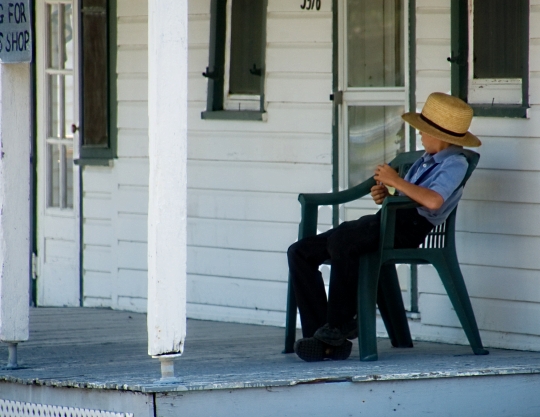
Amish communities in Pennsylvania
- Lancaster County-the Lancaster community is the oldest and best-known of all Amish settlements
- Big Valley-this central PA settlement is home to three distinct Amish groups
- New Wilmington-this large settlement in western Pennsylvania is a quite conservative Amish affiliation
- Indiana County/Smicksburg-3,000 Amish live in Indiana County in west-central PA
- Somerset County-the Somerset County group is small, but is the second-oldest Amish community in North America and unlike most others
- Other Pennsylvania settlements-Pennsylvania is scattered with Amish settlements, some comprising a half-dozen or more congregations, some just a handful of households
Lancaster County
Lancaster County is home to the oldest (founded circa 1760) and largest Amish community in the world, with 179 church districts as of 2010 (see Amish Studies website for more on Amish populations; Lancaster vs. Holmes County, OH size ranking also explained here). The Lancaster community includes over a dozen congregations located in neighboring Chester County.
Lancaster County Amish drive grey-topped buggies. Nearly all Lancaster church districts are considered to be of the same affiliation. There is some variety of practice and technology among districts, with more conservative Amish generally living in the southern half of the settlement. Lancaster Amish are considered to be among the more progressive when it comes to technology allowed.
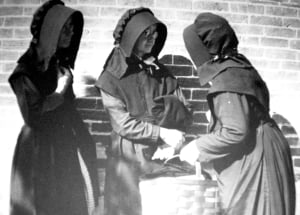
Farming remains important to Lancaster Amish, though population pressures have limited agricultural opportunities. Some Amish have begun small-scale produce operations, suited to labor-intensive agriculture on small plots of land.
Business has been another way Amish have made a living in the face of high land costs. Small business is very important in the Lancaster Amish economy, with an estimated 2000 Amish-owned companies. These include manufacturers, builders, quilt makers, furniture shops, market stands, and a variety of others (read more on PA Amish furniture).
Lancaster Amish have also formed numerous daughter settlements in states such as Wisconsin, Indiana, New York, and Maryland.
Lancaster County is by far the most heavily-visited Plain community, and has developed a thriving tourist industry. Some Amish participate in tourism, either operating businesses selling product to tourists, or in some cases catering directly to tour groups. Tourism is controversial among Amish, with some seeing it as detrimental to the community, and others considering its positive side in the economic support it provides.

Lancaster County became known to the world after the tragic schoolhouse shootings of October 2006, in which five Amish girls died, and five were wounded, at the hands of a disturbed gunman. The Amish response of forgiveness became a headline story around the world which inspired many.
Old Order Mennonites in Lancaster County
Lancaster County is also home to a large population of Old Order Mennonites, who populate the northern end of the county, near Ephrata and its environs. Old Order Mennonites are distinguished from the Amish here by their black-topped buggies and bicycles (local Amish primarily use push-scooters instead).
Also know as “Team” Mennonites, this group has maintained a stronger connection to farming than the Amish, and rely more heavily on tractors as well to manage and work the land. Old Order Mennonites and Amish cooperate on education and operate joint schools, attended by children of both groups.
Old Order Mennonites also distinguish themselves in the style of plain dress worn, and by the allowance of public electricity and telephones in the home.
Big Valley
Pennsylvania is home to the well-known settlement at Kishacoquillas Valley, also known as “Big Valley” (Mifflin County). Big Valley is exactly that—a 30 mile-long by 5-mile wide valley, which is home to three distinct groups of Amish—the so-called Byler, Renno, and Nebraska groups. These groups are most easily distinguished by the coloration of their carriages—yellow (Byler), black (Renno), and white (Nebraska).
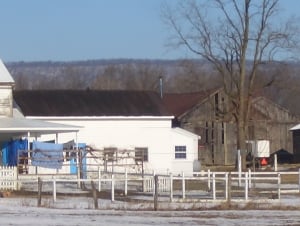
The Nebraska Amish are among the most conservative in Pennsylvania and in Amish society as a whole. There are various theories as to the reason for the unusual color patterns of the carriages here. Big Valley is distinct in its diverse Amish population.
Big Valley is the third oldest of all Amish settlements (founded around 1791) and is home to around 30 districts spread across its three main affiliations.
Belleville in the center of the community is home to a well-known auction building, where Amish and their neighbors trade livestock, share meals, and chew the fat. Big Valley remains largely off the tourist trail due to its fairly remote location.
New Wilmington
The small college town of New Wilmington, north of Pittsburgh, is at the center of a quite conservative settlement of Amish. The New Wilmington group is the 4th largest in the state, with approximately 3,000 Amish in 18 congregations as of 2010 (see Amish Studies).
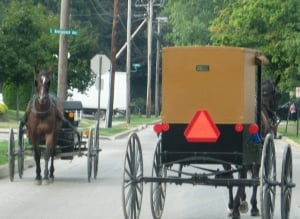
The New Wilmington Amish have origins in the Big Valley settlement, specifically with Big Valley’s Byler group.
The New Wilmington Amish directory describes members of the community often traveling between New Wilmington and Big Valley on foot—a distance of 250 miles lasting 5 or 6 days. “Byler” is by far the most common last name in the New Wilmington community.
Travelers in the New Wilmington settlement will likely notice two distinct colors—the unusual burnt-orange hue of the buggies, and the preponderance of blue—nearly all Amish doors are painted a sky blue, and local Amish stick to wearing shades of blue and purple.
New Wilmington is the only surviving Pennsylvania community founded in the 19th century (1847).
Indiana County/Smicksburg
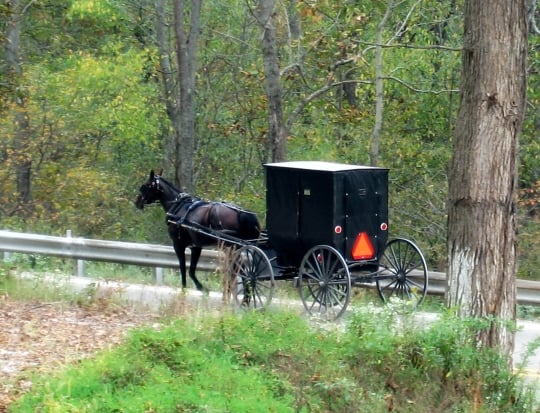
The area of Smicksburg in Indiana County is home to another settlement of Amish of a similar size to New Wilmington (18 church districts), though it was founded over a century later, in 1962. Amish here drive Midwestern-style black buggies.
Somerset County
Another distinct Pennsylvania Amish settlement can be found at Somerset County in the south-central part of the state on the Maryland border.
Somerset is unusual among Pennsylvania settlements and in fact among nearly all Amish communities in that it is home to one of the only groups of Amish who hold Sunday service at meetinghouses, rather than practicing home worship.
Founded around 1772, Somerset County is the 2nd-oldest Amish community in North America. Despite its nearly 240-year history, this settlement remains tiny compared to Lancaster County, with a mere 5 church districts.
Other PA Amish settlements
Pennsylvania is also home to a large number of smaller, off-the-beaten path Amish settlements.
The Lebanon County (1941, 6 church districts) and Dauphin County (1978, 8 districts) communities are two Lancaster daughter settlements located in neighboring counties to Lancaster.
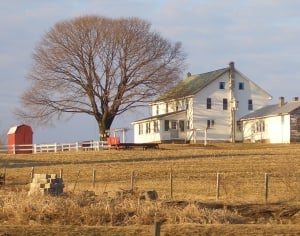
The sizeable Juniata County Amish settlement (1950, 7 districts) has roots in the Big Valley community, a spin-off Renno Amish community. The Sinking Valley setllement also consists of settlers from the Big Valley settlement, making up a single church district in an isolated valley a dozen or so miles west of the home community.
Crawford County is remarkable for being the county containing the greatest number of individual Amish communities, with a total of 7 as of 2008 (see Amish Settlements Across America: 2008). Significant settlements in this county include the community at Atlantic (1924, 6 districts), Spartansburg (1966, 9 districts), and Conneautville (1969, 3 districts).
In Clearfield County, a stone’s throw from the town of Punxsutawney (of Groundhog Day fame), one finds a good-sized Amish settlement of 8 congregations. The only PA Swartzentruber Amish community is found in Cambria County.
Dozens more Amish communities, many just one or two congregations in size, can be found throughout Pennsylvania.
Pennsylvania: An Amish heartland
Pennsylvania is home to a wide variety of Amish settlements, ranging from the very conservative to the more progressive. Lancaster is clearly the state’s most prominent community and will continue to be so, despite having faced skyrocketing land prices and urban encroachment in the latter half of the 20th century.
Though there has been significant out-migration in recent years, Amish continue to form new settlements in Pennsylvania, with a number being founded in the past decade.
Pennsylvania and Ohio have long been considered the foremost states when it comes to the Amish. The two states have nearly the same amount of settlements and total Amish population. Additionally, the Lancaster settlement is nearly identical in size to the large Holmes County, Ohio Amish settlement.
Ohio is home to a larger number of individual congregations, however. Pennsylvania congregations tend to be larger on average. Despite their similarities in size, in the popular imagination, Pennsylvania remains the state most readily associated with the Amish, and Lancaster the best-known and most heavily-visited community.
For further information, see:
The Riddle of Amish Culture, Donald B. Kraybill
“Amish Population by State (2010)” Young Center for Anabaptist and Pietist Studies, Elizabethtown College(http://www2.etown.edu/amishstudies/Population_by_State_2010.asp)
Amish Settlements Across America: 2008, David Luthy
The New American Almanac 2010, Raber’s Bookstore (Baltic, Ohio), Ben J. Raber
Photo credits: PA Amish boy-Alonso Javier Torres; Amish women old photo-Russ Glasson; Intercourse PA sign-Kim Davies; New Wilmington Amish buggies-WCN 24/7; Smicksburg buggy-KitAy



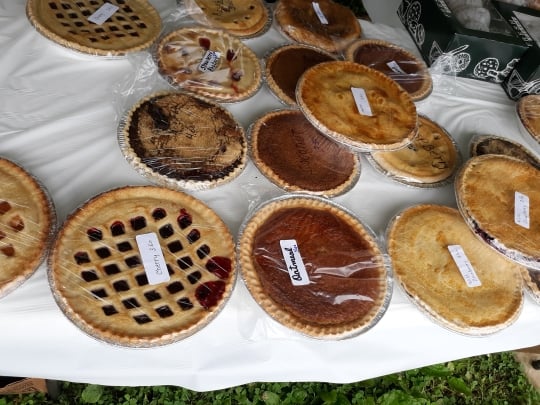
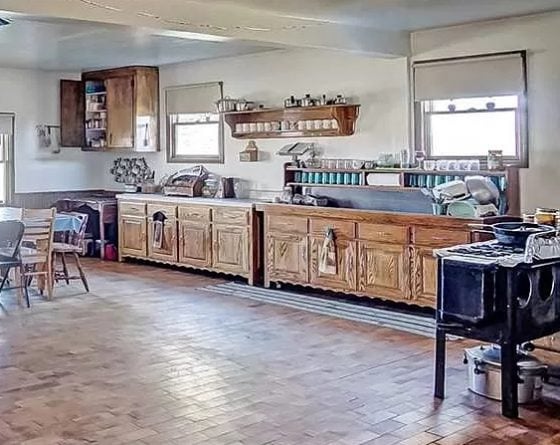

I grew up in Atlantic, PA (Crawford County). It’s exciting to see my tiny village on this site. 🙂 As a matter of fact, my parent’s home has Amish across the street, kitty-corner, and the biggest of the 4 different schools is only 3 houses down from their place. It was a great place to grow up.
It’s easy to tell when friends and family come up from New Wilmington- the brown buggy tops are a dead giveaway!
Atlantic also has it’s own auction in the spring and several new “bent and dent” stores have sprung up in the past few years.
Nice to hear from you Amanda. I almost made it up to Crawford Co this summer but not quite 🙂 Lot of Amish communities in that county.
Where is Crawford County please? I believe Titusville is located in Crawford County and I will be there for only two days. I would like to visit the Amish Communities while there next week. Please email and let me know asap. I fly in next week. Thanks so much!
Crawford co
Crawford county is south of erie and also surrounds Erie . i lived out in Cambridge springs for 10 yrs or so and lived by the old sect Amish out there is a faily large settlement along with Mennonites i admire the hard work these people do everyday
Crawford County
For Margorie, who asked where Crawford County was… Crawford County is in northwestern Pennsylvania, south of Erie County (where Erie is located). The county seat is Meadville.
Yes, there are Amish around Titusville. In fact, besides downtown Meadville, and perhaps downtown Titusville, I can’t think of an area of Crawford County that does not have an Amish community. We have several flavors of Amish communities from three New Order Amish communities near Conneautville, Troy Center, and at the Mercer County line near Jamestown; with the remaining parts of the county as Old Order; with a small Nebraska community along the Ohio state line near Pierpont and Linesville.
Farming, small business, and the timber industry prevail throughout. There are Amish owned greenhouses, excavating companies, and flooring and countertop businesses, as well as several Amish run stores from Old Order to New Order. A large percentage of Amish farms in this part of the state have gas wells, which provide heat and extra revenue to the farms.
Pennsylvania Amish
My Fathers family grew up in the Atlantic Pa. area. He still has relatives living there today.He was the son of William (Bill) Fisher. My grandfather passed away when my father was a teenager.Granddad fell from the roof of a barn and died in his sleep the next morning. My grandmother was a Wengerd and this is the part of the family that lives in the Atlantic region yet today. Grandmother remarried yrs. later to Bishop Andy Hershberger and lived in Troutville Pa. until Andy’s death. Then moved here to NE Ohio to live with my dads only sister.Grandma died there of complications from Alzheimer’s disease.She was buried in Atlantic Pa.I have many wonderful memories of both Atlantic and Troutville Pa.
Atlantic Amish
Betty I appreciate you sharing. I was very near the Atlantic community last summer but unfortunately did not have time for a visit. There is a book out there on the history of the Atlantic settlement I believe.
looking for the Fishers
My grandfather sold “bootonware” (plastic serving ware I believe) with a Mennonite man named Mr Fisher, my father would talk of this family and as a little girl I would visit them. I would love to find this family and reunite!! Any help would be appreciated!!!
Living among the Amish
This may sound odd, but do any Amish families ever have rental properties on thier farms? Have a friend who is seeking a really peaceful, quiet place to raise his child without all the modern day vices. He is not Amish, but grew up in Lancaster County, and has always envied that simpler life.
excited to see info on my new neighbors from smicksburg… they have started a new community here in upstate ny! and more are moving in all the time. they have revitalized this community. they have reclaimed the abandoned farmland. it has certainly been an interesting year learning their ways, etc. from them. i have gained many close relationships which i hope will last a lifetime.
Looking for an Amish Family to stay with
Hi, my name is Sofia and I have been studying the Amish culture for a long time now. This Feb I will be travelling to Penn so that I can finally go visit one of their communities, but I was hoping I could have a less touristy experience and stay with a family instead of staying at a local inn. I really want to get to know the Amish and their lifestyle, and maybe even find someone to correspond with me.
Any good tips on which communities’ bureaus I should call first to try and set something up? I have done some research already and it is as hard as I thought it would be to find any valuable information.
Try contacting Professor Donald Kraybill at Elizabethtown College in Elizabethtown PA. I am sure you wll be able to find his email address on the colleges website. He may be able to give you some advice and insight on the Amish communities here in Lancaster County.
Nickel Mines School
My Amish neighbor heard at church yesterday, that someone made an attempt to harm the children again at Nickel Mines School. The guy was supposedly arrested inside the school, and taken to jail She was wondering if this really happened or perhaps only a rumor? or if it did indeed happen??
Brenda a little late here but I have not heard anything about this, I think it must have just been a rumor.
Pennsylvania Amish
Hello…just wanted to make a comment…my husband and I travel throughout 5 states going to Amish communities…we have had the opportunity to meet so many wonderful people..we have become friends with so many and have met several generations of families throughout the 5 states. It is so interesting to see how different each settlement is …
Visiting Amish Community/family
I’m Interested in visiting an Amish Community/family (with my wife and 3 year old daughter)that is not turisty. How would I go about this?
Sofia:
I also would like to visit & stay with the Amish. I continue to discover(genealogy)my Mennonite roots in Lancaster County, PA. Hopefully, when I do locate my relatives in the area I will have the opportunity to meet with them in the near future.
Also thank-you Kendal for the information.
Linda from Northern Illinois
So glad to see your comment! I too have discovered Mennonite roots in Lancaster through genealogy research. 🙂
I'am new on here
I LOVE Having friends to email
hi, how fortunate would i be to have a penpal in Amish PA? I know a lot about the Amish lifestyle and Faith 🙂 …. I am interested in connecting with a PenPal, Personally to really learn more about their way of life and possibly see a door open up where i could stay with them for a little while. I have a warm, friendly personality, and Love God, too! I love the fact that the Amish are sincere about being Modest! 🙂 And, too, it has been a desire of mine to learn to live on and work a farm! …. I look forward to an open door, God Bless!
Really like the Amish
I HAVE BEEN STUDYING THE AMISH FOR MANY YEARS AND NOW LIVE IN NEWPORT, PA.
I WOULD LOVE TO VISIT WITH AN AMISH FAMILY ON A FARM AND LEARN ABOUT THEIR WAYS.
IT WOULD BE OF GREAT INTEREST TO ME AND I HOPE THAT SOMETHING CAN BE ARRANGED SHORTLY.
WITH ALL DUE RESPECT
AND
BLESSINGS,
JOAN E. SOUDERS
puppies for sale from amish farm
why do the amish mis treat their animals so bad. they over work their horses, neglect their cows and their puppy mills are notorious for abuse, neglect and filth. how is this type of abuse ok in the amish community?
I’m quite close to the Amish in Synder, Union and Perry counties in Central PA. The horses work hard at times but that is what they are supposed to do. 80% of the time they are out in pastures enjoying themselves. I grew up with using horse power on our farms and those animals were treated with utmost respect. I’ve looked for “puppy mills” and never found one. Amish do have puppies for sale at times but most of the ones I’ve seen are around $35.00 and a good home is always the prime objective. Amish beleive that animals are here to help them live the way they do and they respect animal life.
Amish Contractor not returning calls or messages after building he roofed blowing apart
HI I am trying to get Stoltzfus Contracting (Elimsport / Allenwood , Pennsylvania to come back and repair the roof his crew put on my barn with new siding last summer at over $27,000. I have left a paper message to call me on the door of his business Saturday. Yesterday I left two voice mail messages for him on the telephone and another today. Yesterday when I stopped out at his place I spoke with his son who recognized my name from the written message on the door and said didn’t he get a hold of you yet? How can I get him to make good on his business’s work and repair what has already blown apart not even a year later?
Furniture Repair
I live in Aldie, VA and am wondering if there is an Amish Community that does wooden furniture repair?
looking to buy new pallets
i owne a pallet co and i want to buy truck loads of pallets
cmart2727@yahoo.com
Amish Experience
Hi
My husband and I are planning a visit to the US this summer and We are hoping to come to Lancaster for a day or two. We really admire the Amish way of life and were hoping we could experience staying with them instead of the usual hotels. Naturally we would respect all customs and would be willing to ‘help out’ where we can.
Look forward to hearing from you
Kind Regards
Bilkish
Amish in western berks
I live in western berks county and wanted to know about the amish in my area. I have seen more and more home bought by amish in this area. Do you know any more info about the growth in this part of the state. Town that are seeing more growth are Bethel, Mt Aenta, Rehrersburg, Myerstown, PA
Berks/Lebanon counties
The Amish living is Berks and Lebanon counties are not new to the area. In fact, the “Northkill” settlement was one of the first areas settled by the Annabaptists/Amish/Mennonite faiths. The “Northkill” area is in north-western Berks county (Bernville area). You still find lots of Amish and Mennonite homes in that area, especially around Mohrsville and further west around Bethel,Stouchsburg (Marion township) heading into Lebanon county.
The Yoders in North America can all almost trace their tree back to 3 orignal Yoders that came to settle the Oley Valley area (Berks county)were from Steiffesburg, Switzerland – Hans, Yost (my direct Ancestor) and Christian Yoder. They all came here in the very early 1700s to practice their faiths, free from the Swiss government which persecuted anyone who wasn’t of the Catholic faith. Hans and Yost were of the Lutheran faith while while Christian was an Anabaptist. Christian left Pennsylvania and headed west, settling in Indiana eventually. (I may have some of my facts wrong, for more information about those Yoders, go to Yodernewsletter.org.
You’ll also find very many Amish and Mennonite if you head north up route 222 – from Blandon, Fleetwood to Kutztown. You are almost certain to drive by young Amish and Mennonite people and children riding their bikes along 222.
I am related to both Amish and Mennonite – Yoder, Moyer, Eberly, Ebersole, Zeimer, Breyfogel, Hoch, Peters, Dreibelbis. I still speak PA Dutch- my grandparents and Dad all spoke the language fluently. When I was in elementary school (Conrad Weiser in Berks county-area covers Wernersville, Robesonia, Womelsdorf areas- and it borders Lancaster and Lebanon counties, required all students to learn German with classes beginning in 2nd grade. (you might think I am and old geezer but not quite, haha, I just turned 50) That is not a requirement any longer which I think is sad. I love my Pennsylvania Dutch heritage but there are fewer and fewer people who speak the language.
If you are in Berks county, you must go to the Kutztown Folk Festival this summer for a real taste of what it is/was like to be Pennsylvania Dutch in this area.
Karen Moyer-Francis
South Heidelberg Twp., PA
Western Berks County
Oh and another side note – I graduated from Tulpehocken School District that covers the areas you mentioned. There were many Mennonite and Dunkard Brethren in that school. There was a Moyer boy who was Mennonite that sat behind me in homeroom that always kidded with me about marrying him so I wouldn’t have to change my last name- haha.
My Favorite Place in the World..
I live in Baltimore. We travel to Lancaster on a regular basis.
Every year the first week of August the World BoardGaming Championships are held there (we stay at the Lancaster Host)
Part of my joy is that I’m in this beautiful place with so much history…. and it’s warm and it’s summer and there are so many things to see and do..
As a young wife and mother I worked with La Leche League and knew a woman named Penny who delivered many of the Amish babies…
I would like to travel to Lancaster next week. Are there SwartzenTrubber Amish in Lancaster. Where would I find the most conservative Amish there if there are no Swartzentrubber?
would like to visit the Amish Communities in PA
I am arriving in Pittsburgh, PA in a few days. I am driving from Pittsburgh to Titusville, PA. Can you help me find Amish Communities to visit while I am there between point A and point B. I only have a few days in PA.
Thanks very much!
email me asap to getfitbymj@gmail.com
Thanks so much!
lifemakeover
have been studying amish community for years. family is ready to fully integrate into amish community. pls advise any home(s) in amish community for sale or lease for large family. modestyisbest@yahoo.com
I would argue that Ohio’s Amish community is larger than Pennsylvania’s per every other site other than this one.The population is much larger and Holmes county is known as the largest Amish community in the world per the Guinness world record.
Which is larger, the Holmes County or Lancaster Amish settlement?
In most places you’ll probably read Holmes County is larger and going by number of church districts there are definitely more Amish churches there.
However I’d say in terms of population they are quite similarly-sized and may even be considered too close to call (without doing an up-to-the-minute population count). Holmes County has more church districts, Lancaster has fewer but larger districts. That was what the researchers at Elizabethtown College found in 2010. Here’s an excerpt from what I wrote on the new estimates coming out that year:
“The big shocker is Pennsylvania coming in ahead of the Ohio Amish, and Lancaster County a hair ahead of Holmes County (by 25 people, which means that if Holmes County delivers more babies this week, they could retake the lead!) With the numbers at around 29,000 each, they could basically be considered the same size.
However, Holmes County has traditionally been considered significantly larger than Lancaster in previous Amish population estimates.
Why the change? Taking into account differences in average church district sizes. The authors of the study used settlement-specific church district sizes to figure the averages this year. Previously, the average of 135 Amish per district had been applied to all settlements nationwide.”
https://amishamerica.com/pennsylvania-amish-edge-out-ohio-in-latest-amish-population-figures/
Holmes Co. was widely said to be larger before that probably because people just compared number of church districts, assuming a church district here is the same as a church district there. But after analyzing settlement-specific church directories they found that districts in Lancaster average around 165 people vs. 130 in Holmes which is pretty significant.
If you look at the current numbers Holmes is slightly ahead in population (while in 2010 when this PA Amish article was written Lancaster was). For current estimates see: http://www2.etown.edu/amishstudies/Largest_Settlements_2012.asp
These are estimates so the “real picture” could vary and be obscured by things like significant out-migration one year or more churches happening to divide in a given year resulting in more, but in reality smaller-than average churches, etc, so there is some imprecision baked in the cake. But looking at the numbers in a more careful way has given us a picture of two settlements much closer in size than originally thought. Going by church district numbers without this analysis can give the impression that Holmes could be even 30% larger than Lancaster, but this is not the case. Due to the closeness it’s probably safer to just say these are the 2 largest Amish communities (I have added a link to this explanation in the relevant bit of the post above).
Similarly, Joseph Donnermeyer & co. last summer released a nationwide Amish census that found the 2 communities to be very closely sized, with HC around 30,000 in pop. and Lancaster about 29,000. See: https://docs.google.com/viewer?a=v&q=cache:QvsozPIeRjIJ:news.cincinnati.com/assets/AB192776731.DOCX+&hl=en&pid=bl&srcid=ADGEESjSFq5fjWjhOe5Gqyiz9JCGh-X-qHvmXWOiOvDjghV8-GmCv-2OQcafNPHEkLTXmqvIidOnybq3R1_yoer7VWBxVQ00JTv-Zg7MgVgnj5FUwJsVfiAfKVzKMmFCSXjSG9WHjj4M&sig=AHIEtbThkStvrBAdtkSYJSlMeJpRsDo_cA
This church district size variation can make an even more drastic difference in other communities. In Indiana for example communities like Allen County and Daviess County average a very high number of families per district (in the 40s) while others in the state such as Adams Co and Nappanee much less (mid-20s). That can make a huge difference when estimating number of people, so going by church district number alone can be misleading.
BTW my family came from Somerset,PA and help found Somerset Ohio so I have some background in the Amish community though the family left sometime around the turn of the century.
Newspaper for classified ad
I want to advertise a wringer washing machine for sale in NJ in excellent condition, but I don’t know where to place an ad. Is there a newspaper catering to the Amish where I can place this classified?
Newspaper for classified ad
The Budget is your best bet for placing your ad. It is a newspaper published in Ohio, but is read nationwide by Amish & Mennonite communities. Hope this helps!
Christen:
Perhaps you or Erik could give more information on The Budget published in OHio. My purpose is locating relatives in the Amish & Mennonite communities; especially in Pennyslvania. I believe I have seen outdated The Budget in various Amish run stores. I have fanned thru them but would like more recent info. Does The Budget give addresses for correspondence?
Sorry for all the questions but I’m searching for more info.
Thank-you.
Linda here are a couple of posts on the Budget, and also their web address where you should be able to find the most current info:
https://amishamerica.com/amish-publications-addresses-order-subscription-info/
https://amishamerica.com/the_budget/
http://www.thebudgetnewspaper.com/
The Budget
I receive The Budget weekly and I noticed there is a section where one can write in and ask for information on things. You might try writing to that column. The column is called “Information Please” the column states you can send questions to: Information Please, c/o The Budget, PO Box 249, Sugarcreek, Ohio 44681 I have seen folks write in looking for a long lost family member or friend, so this may be something for you to try. Include in your writing where readers can mail information to you. Hope this helps! 🙂
Amish stay
My mother and I are visiting Lancaster County in October for my birthday. Does anyone know of any Amish families that host Englischers overnight? Or any Amish-run B&B’s that I obviously can’t find online because they don’t have electricity?
Amish Community - Punxsutawney, Pennsylvania
Hi, I have heard that there is an Amish Community in Punxsutawney, Pennsylvania. Do you know the community that I mean, or are there many around Punxsutawney? If you know the one I mean, is it possible to write a letter to them? Would they receive it and reply to it and what is there address? Many thanks!
RV Airstream Restoration
Hi,
I am looking to find out if there are any Pa Amish shops willing to do an interior restoration of a 17′ Airstream RV Trailer. Floor to ceiling restoration, including cabinetry etc.
Thanks,
Gordon
No one may see this post, since it’s attached to an encyclopedic entry, but just in case…!
I live in Ohio’s Amish area and was recently in a local restaurant where there was a large group of what appeared to be Pennsylvania Amish, according to coverings and other signs. The women had the heart-shaped coverings (as opposed to Ohio’s “round” shapes) and black full-body aprons where the neckline was kind of a sweetheart-shape (those aren’t worn here).
I’ve seen the black “sweetheart neck” aprons before on some Penn Amish, but what surprised me was that the people were wearing somewhat bright fabric (buttercup yellow, a brighter light blue) that also had a very subtle pattern in it (looked like a very light checkerboard). Several of the families had all family members wearing the same fabric in dresses and shirts so they matched. Several of the men were wearing suspenders that also were some light colors with differing subtle patterns, like stripes or dots.
I’ve never seen any Amish wear any kind of pattern, even subtle, (except for Beachy Amish, which is different). I’ve never seen any Mennonite or Amish person with that combination of the heart-shaped covering and full-body black apron (withe the shaped neckline) along with any kind of almost bright and patterned fabric. It was like a combination of Penn Amish and Mennonite in a way.
Are there Amish in Pennsylvania who wear patterned fabric, even subtle, and patterned suspenders? Or maybe they were from another state and kind of moved off the “traditional” path in a small way?
looking for experianced quilters
I am looking for experienced quilters. Any Amish paper I can place my ad in. Please help.
Thank you
Barbara Glab
My visit home to Philly
I grew up in Philly, I came home for a visit in the earlt part of Sept. I was able to make it to Ready Terminal, I was so excited that the Amish had different set ups there. I wnet there almost everyday. (breakfast, except Sunday and Monday). I was also able to bring back some of the produce. I have such fond memories of traveling to Lancaster to see purchase produce, etc. That’s all I have talked asbout since I returned back to Atlanta. Does anyone know if the produce can be shipped? It is well worth it. I will always have a soft spot in me heart for the Amish Community. 🙂
I am trying to locate a man who bought a horse in the Ohio mix auction on May 12 2014. His name is David E Shetler from Saegerstown, Pa. The horse he purchased is very important to me. If anyone knows how I can get in touch with him just to see how the horse is doing please let me know. Thank you.
Beware
I have been researching puppy mills in the Amish community and am sickened by their attitude toward these creatures of God. Yes, it is a reasonable business venture to make money on breeding animals, but the animals deserve to be kept clean, fed and well taken care of, for the return on investment if no other reason. I’m also disappointed that the authorities haven’t done more to correct this situation. Sad that people who claim to only want to live the life by Jesus’s laws and earn themselves a place in heaven can treat other living creatures so inhumanely. Sure opened my eyes to the hypocrisy in the Amish communities.
photo permission
I found this photo on your site.
amish-smicksburg-indiana-county-pa
May I have permission to use it in a collage I am making about Central Pennsylvania?
Looking forward to hearing from you.
DMeyer
Franklin County, PA
Are there any Amish in Franklin County, PA? I know there are some OGBB of the new conference there in the Chambersburg area.
Amish in Franklin County, Pennsylvania
Adam as of 2013 there were 2 communities either entirely or partially in Franklin County. One is the Path Valley community, 5 churches in size, and the other is the Newburg/Cumberland Valley community, which would also be located in Cumberland County (6 churches in size). Hope that helps.
http://kb.osu.edu/dspace/bitstream/handle/1811/57700/JAPAS_Donnermeyer_Luthy_vol1-issue2_pp107-129.pdf?sequence=1
Franklin County, Pa
Yes, there are many Amish in Franklin county. You can spot many from traveling on I81. They seem to be a spill over from Cumberland county. They have farms, roadside stands, schools and stores hidden around the country side. Amish can also be seen in Greencastle, Waynesboro and Mercersburg.
Thank you Erik and Jerry, very helpful info. I’ll be driving through there this summer and I will be on the lookout. Thanks again.
Looking for mare with neck freeze brand 1k753
Looking for standardbred mare from Maine who came to pa in July 2016 at age 4. Her neck freeze brand is 1k753. If seen, please call 207 522-5865. I want to buy her. Thank you.
Looking for
There was an Amish gentlemen whom rented a farm in Bedford, PA whom picked his horses up without notice. The one person got hurt from the horses when she was trying to feed them for the gentlemen. They was asked to take care of the horses for him because he didn’t live in the area he lived up on the other side of state college. All they know is his first name is John. It’s been 3 months and she is now in a cast because her foot won’t heel. Any help would be greatly appreciated
York County?
I have seen Amish in Seven Valleys/Codorus areas but I cannot find information on their culture being in York County.
Amish in York County, PA
There are Amish in a couple of locations in York County.
First, there are a handful of church districts (4 or 5?) which are considered part of the Lancaster County settlement, which you come across once you cross the Susquehanna River on Route 372. The only mud sale in York County is held nearby at the Airville Fire Company: https://amishamerica.com/airville-mud-sale-york-county-pa/
Second, a separate settlement was formed in 2016 in the Glen Rock area of York County. This is an interesting story in its own right as the approach to founding this community was unusual: https://amishamerica.com/amish-settle-york-county-pa-in-new-model-of-migration/
Unfinished furniture
I am looking to purchase unfinished primitive furniture in Lancaster and Belleville, pa.
If you know of a place, please reply. Thank you
Sullivan & Bradford County's
Any Amish builders live in this part of Pa.?
sugar grove pa
this community in sugar grove pa is dear to my heart
they have welcomed me as a friend
i have leaned so much from the folks i met in sugar grove pa
they also answer my dumb questions
16350
CONFUSED
I saw a public TV documentary on Mennonites, ‘Life in Belize’ It details a strict group moving to Peru to start from zero. The trip was amazing as they had to sell all, and move to Peru, all the various worldly aspects somehow managed, and they brought with them heavy equipment to clear land, to form a more perfect, strict life. In less than a year they had 40 families with them! If heavy machines and generators are OK, to build with, why cant they drive cars?
OK, I have always admired the lifestyle, 40 yrs as a ‘English’ Christian leaves me barren, and alone. I even did missions work for free, after being involved with a great many churches. but can find no agreement, the Word is primary always.
My only exposure to Amish/Mennonites is lite touches of Lancaster Amish, and one short retreat with some Mennonites. I know little, so cant understand why they stay in such close proximity to the heathen. (lititz – Lancaster areas)
Also, always thought electricity and machinery was forbidden! Some have electric to the homes also, cell phones.
I am a master welder and a expert computer tech. PC’s only. I smoke a pipe, and felt relieved when I saw an Amish doing so as well!
Would I be accepted as a 71 year old able to use my skills?
We have lost, or given away most of the items we owned and now rent after owning homes became too much work/expense.
How does one find what may be an area of acceptance, domestically or otherwise? What do you recommend?
Closest Amish visit to NYC
Hi there, your site is so interesting and full of information. I wish I had more time to read it all and than go out for a visit. Unfortunately I only have today and tomorrow. I am in NYC and would love to get on a train with my bike and go for a visit. Can you advise where the closest place to go would be? What area would be most interesting? Some place i could stay for a night?
I have been living in Israel most my life and everything is so intresting to me.
Thank you :}
Maggie
Farm for Sale in NW Pennsylvania
I would like to sell my farm to the Amish community; I believe in their lifestyle and their religion. How may I contact them to let them know the land is available for purchase? There are 30 acres with buildings, home, barn, pond, and more: a Northwestern Pennsylvania-based nonprofit organization is seeking the sale of the farm along with inheriting the nonprofit business (shop, table, chairs, tools, etc).
Come and wander through our lush gardens of organic vegetables, herbs, fruits, and edible flowers. Explore our 30 acres of nature trails, red wiggler worm composting system, wind/solar energy system, geothermal & biomass heating, geothermal cooling, stained glass mosaics, spring-fed 1/2 acre pond, greenhouse, solar-powered gravitiy-fed irrigation system, yurt, stream, mushroom production, fruit trees, woods, meadows, earthen oven, hi tunnel, Hugelkultur, straw bale house, pavilion, and benches.
Thank you for this venue and I look forward to communicating via email. Only serious offers with approved financing. Thanks!
Depending on where you are located in NW Pennsylvania, I would advertise it in a local classified paper, such as the Area Shopper. Perhaps post on the bulletin boards at feed mills, etc. Just like you are trying to sell it to anyone else.
train derailment
The Enon Valley and New Wilmington Amish settlements are close to and downwind of the East Palestine, OH train derailment and subsequent toxic chemicals release.
Does anyone know how these Amish people are doing??
Train Derailment
The Enon Valley and New Wilmington Amish settlements need to MOVE to:
PANOLA COUNTY, TEXAS
Sparsely populated 27 people per Sq. mile: 40 to 45 inches of rain per year, hills and dales. Sandy loam, hay fields and gardens we have them.
Woods and Forest both Pine and Oak, Hickory and Pecan are in the bottoms,
240 day growing season. Yes, 240 day growing season, really we’re down south, you’ll like it
Here in Texas, you are FREE. Period.
Come on down, tell your cousins about paradise in Texas on the Louisiana border! This will be the biggest and best move since you immigrated!
I’m not selling, I’m just telling; if you needed a reason to move; AND YOU DO NOW, it’s time to move to Texas.
Tell some of them Wandering young men to travel to PANOLA COUNTY TEXAS, they’ll return telling you this is the time, and PANOLA COUNTY TEXAS is the place.
Central Pa
I live in central pa and would like to haul Amish local at first